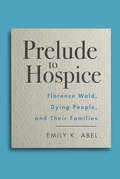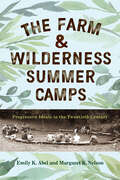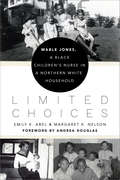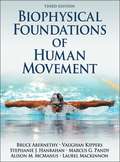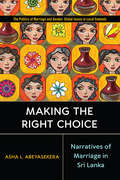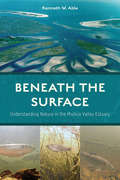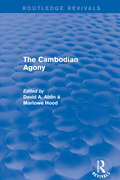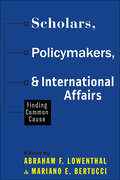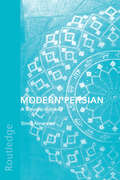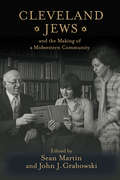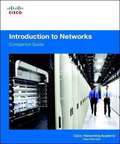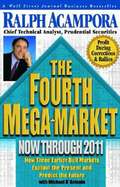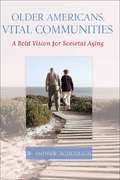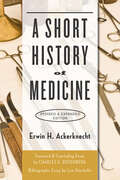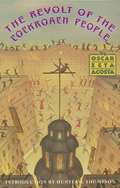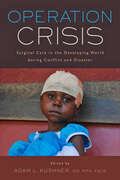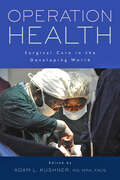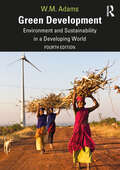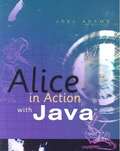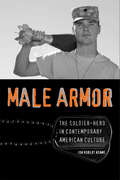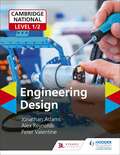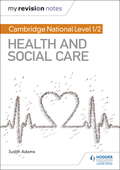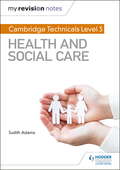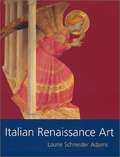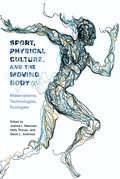- Table View
- List View
Prelude to Hospice: Florence Wald, Dying People, and their Families (Critical Issues in Health and Medicine)
by Emily K. AbelHospices have played a critical role in transforming ideas about death and dying. Viewing death as a natural event, hospices seek to enable people approaching mortality to live as fully and painlessly as possible. Award-winning medical historian Emily K. Abel provides insight into several important issues surrounding the growth of hospice care. Using a unique set of records, Prelude to Hospice expands our understanding of the history of U.S. hospices. Compiled largely by Florence Wald, the founder of the first U.S. hospice, the records provide a detailed account of her experiences studying and caring for dying people and their families in the late 1960s and early 1970s. Although Wald never published a report of her findings, she often presented her material informally. Like many others seeking to found new institutions, she believed she could garner support only by demonstrating that her facility would be superior in every respect to what currently existed. As a result, she generated inflated expectations about what a hospice could accomplish. Wald’s records enable us to glimpse the complexities of the work of tending to dying people.
The Farm & Wilderness Summer Camps: Progressive Ideals in the Twentieth Century
by Emily K. Abel Margaret K. NelsonAlthough summer camps profoundly impact children, they have received little attention from scholars. The well-known Farm & Wilderness (F&W) camps, founded in 1939 by Ken and Susan Webb, resembled most other private camps of the same period in many ways, but F&W also had some distinctive features. Campers and staff took pride in the special ruggedness of the surrounding environment, and delighted in the exceptional rigor of the camping trips and the work projects. Importantly, the Farm & Wilderness camps were some of the first private camps to become racially integrated.The Farm & Wilderness Summer Camps: Progressive Ideals in the Twentieth Century traces these camps, both unique and emblematic of American youth culture of the twentieth century, from their establishment in the late 1930s to the end of the twentieth century. Emily K. Abel and Margaret K. Nelson explore how ideals considered progressive in the 1940s and 1950s had to be reconfigured by the camps to respond to shifts in culture and society as well as to new understandings of race and ethnicity, social class, gender, and sexual identity. To illustrate this change, the authors draw on over forty interviews with former campers, archival materials, and their own memories. This book tells a story of progressive ideals, crises of leadership, childhood challenges, and social adaptation in the quintessential American summer camp.
Limited Choices: Mable Jones, a Black Children's Nurse in a Northern White Household
by Emily K. Abel Margaret K. NelsonWhen interviewed by the Charlottesville, Virginia, Ridge Street Oral History Project, which documented the lives of Black residents in the 1990s, Mable Jones described herself as a children’s nurse, recounting her employment in New York City in the 1940s and 1950s. Emily Abel and Margaret Nelson, whose mother employed Jones, use the interview and their own childhood memories as a starting point in piecing together Jones’s life in an effort to investigate the impact of structural racism, and a discriminatory system their family helped uphold. The book is situated in three different settings—the poor rural South, Charlottesville, and the affluent suburb of Larchmont, New York—all places that Mable Jones lived and worked.Mable Jones was emblematic of her race, gender, time, and place. Like many African Americans born around 1900, she lived first in a rural community before moving to a city. She had to leave school after the eighth grade and worked until a year before her death. And her occupation was that held by the majority of African American women through the twentieth century. Reflecting on her life, local civil rights leader Eugene Williams asked the authors to document the "segregation in Charlottesville that Mrs. Jones endured." This book honors his charge by highlighting the limited choices available to her. It documents the slow progress of change for many African Americans in the South, explores the still little-known experiences of Black household workers in the suburban North, and reconstructs the textured lives that Mable Jones and the many women like her nevertheless carved out in a system that was and continues to be stacked against them.
Biophysical Foundations of Human Movement (3rd Edition)
by Bruce Abernethy Vaughan Kippers Stephanie Hanrahan Marcus Pandy Ali Mcmanus Laurel Mackinnon"Biophysical Foundations of Human Movement, Third Edition," introduces readers to key concepts concerning the anatomical, mechanical, physiological, neural, and psychological bases of human movement. The text provides undergraduate students with a broad foundation for more detailed study of the subdisciplines of human movement and for cross-disciplinary studies. Readers will learn the multi-dimensional changes in movement and movement potential that occur throughout the life span as well as those changes that occur as adaptations to training, practice, and other lifestyle factors. This third edition includes the latest research and improved presentation to address areas of growth and change in the fields of human movement. The following are important updates to this edition: - A new chapter on historical origins of human movement science provides students with an appreciation of the development of the field as well as its future directions. - Content regarding exercise physiology has been reorganized to provide more discrete coverage of key concepts in nutrition. - A new concluding section focuses on applications in the areas of prevention and management of chronic disease, prevention and management of injury, and performance enhancement in sport and the workplace, as well as the benefits of sport and exercise science to work, sport, and everyday living. - Ancillary materials support instructors in teaching across disciplines as they assist students in understanding the breadth of content in this comprehensive text. Using a modular approach to teaching sport and exercise science, "Biophysical Foundations of Human Movement, Third Edition," offers students a structured understanding of how the subdisciplines work independently and in tandem. Following a general introduction to the field of human movement studies, readers are introduced to basic concepts, life-span changes, and adaptations arising in response to training in each of the five major biophysical subdisciplines of human movement. Each subdiscipline is given a brief introduction, including the definition and historical development of the subdiscipline, the typical issues and problems it addresses, the levels of analysis it uses, and relevant professional training and organizations. Multi-disciplinary and cross-disciplinary approaches to human movement are also discussed along with contemporary applications. By studying the integration of knowledge from a number of the biophysical subdisciplines, students will be better prepared for advanced study and careers reliant on the integration of knowledge from various disciplines and perspectives. The third edition offers tools for retaining the material, including learning objectives and summaries in each chapter, a glossary, and lists of web-based resources. Throughout the text, special "In Focus" features highlight key organizations, individuals, and studies from around the world that have contributed to the current understanding of human movement. These features help readers appreciate the evolution of the field so that they may better understand its direction. Students interested in further study will find specialized texts for each of the subdisciplines listed in the Further Reading and References section of each chapter along with updated lists of websites. The third edition of "Biophysical Foundations of Human Movement" offers a comprehensive introduction for students, scientists, and practitioners involved in the many professions grounded in or related to human movement, kinesiology, and sport and exercise science. By considering the effect of adaptations in each of the biophysical subdisciplines of human movement, "Biophysical Foundations of Human Movement" also illustrates the important role physical activity plays in the maintenance of health throughout the life span.
Making the Right Choice: Narratives of Marriage in Sri Lanka (Politics of Marriage and Gender: Global Issues in Local Contexts)
by Asha L. AbeyasekeraMaking the Right Choice unravels the entangled relationship between marriage, morality, and the desire for modernity as it plays out in the context of middle-class status concerns and aspirations for upward social mobility within the Sinhala-Buddhist community in urban Sri Lanka. By focusing on individual life-histories spanning three generations, the book illuminates how narratives about a gendered self and narratives about modernity are mutually constituted and intrinsically tied to notions of agency. The book uncovers how "becoming modern" in urban Sri Lanka, rather than causing inter-generational conflict, is a collective aspiration realized through the efforts of bringing up educated and independent women capable of making "right" choices. The consequence of this collective investment is a feminist conundrum: agency does not denote the right to choose, but the duty to make the "right" choice; hence agency is experienced not as a sense of "freedom," but rather as a burden of responsibility.
Beneath the Surface: Understanding Nature in the Mullica Valley Estuary
by Kenneth W. AbleThe Mullica Valley estuary and its watershed, formed over the last 10,000 years, are among the cleanest estuaries along the east coast of the United States. This 365,000-acre ecosystem benefits from a combination of protected watershed, low human population density, and general lack of extensive development. In Beneath the Surface, marine scientist Ken Able helps the reader penetrate the surface and gain insights into the kinds of habitats, animals, and plants that live there. Readers will gain a better understanding of the importance of these shallow waters; how the amount of salt in the water determines where animals and plants are found in estuaries; the day-night, seasonal, and annual variation in their occurrence; and how change is occurring as the result of climate variation. Throughout the book are insightful sidebars telling intimate stories of where various animals came from and where they are going as they travel through the estuary on their way to and from other portions of the east coast. Beneath the Surface emphasizes the kinds and importance of the animals and plants that live beneath the surface of this unique ecosystem.
Revival: The Cambodian Agony (1990)
by David A. Ablin M. HoodThis title was first published in 1990: Cambodia, it has been said, has gone through the most radical social upheaval and transformation of any country in recorded history. From the overthrow of Prince Sihanouk, who ruled for 29 year, in 1970 to the victory of the Cambodian Communist Party in 1975, Cambodia suffered massive saturation bombing and an unusually violent civil war. It is estimated that half a million people of the seven million total population died. From 1975 to the end 1978 as many as another three million perished because of the brutal policies of the government, and spurred the civil war that has been simmering ever since. In this book, the world's leading experts on Cambodia and the politics of Indochina address the major issues facing Cambodia since the overthrow of the Pol Pot regime in 1978.
Scholars, Policymakers, and International Affairs: Finding Common Cause
by Abraham F. Lowenthal and Mariano E. BertucciHow to strengthen both academic research and international policies by improving the connections between scholars and policymakers.Scholars, Policymakers, and International Affairs shows how to build mutually beneficial connections between the worlds of ideas and action, analysis and policy. Drawing on contributions from top international scholars with policy experience in the United States, Europe, Asia, Canada, and Latin America, as well as senior policymakers throughout the Americas, Abraham F. Lowenthal and Mariano E. Bertucci make the case that scholars can both strengthen their research and contribute to improved policies while protecting academia from the risks of active participation in the policy process.Many scholars believe that policymakers are more interested in processes and outcomes than in understanding causality. Many policymakers believe that scholars are absorbed in abstract and self-referential debates and that they are primarily interested in crafting theories (and impressing other scholars) rather than developing solutions to pressing policy issues.The contributors to this book confront this gap head-on. They do not deny the obstacles to fruitful interaction between scholars and policymakers, but, drawing on their own experience, discuss how these obstacles can be and have been overcome. They present case studies that illustrate how scholars have helped reduce income inequality, promote democratic governance, improve gender equity, target international financial sanctions, manage the Mexico–U.S. border, and enhance inter-American cooperation. These success stories are balanced by studies on why academic analysts have failed to achieve much positive impact on counternarcotics and citizen security policies. The editors’ astute conclusion identifies best practices and provides concrete recommendations to government agencies, international institutions, nongovernmental organizations, and funding sources, as well as to senior university officials, academic departments and centers, think tanks, established scholars, junior faculty, and graduate students.Clearly written and thoughtfully organized, this innovative book provides analytic insights and practical wisdom for those who want to understand how to build more effective connections between the worlds of thought and action.
Modern Persian: A Course-Book
by Simin AbrahamsModern Persian begins with the teaching of the Persian alphabet. It aims to provide the student with the necessary skills for social interaction, as well as a basis for the study of modern literature. The course consists of seventeen units and favours teaching by communicative and contextual learning. Most units begin with a reading exercise used to introduce an item of grammar and new vocabulary, followed by explanations and drill exercises aimed at consolidating the student's understanding. Complete with Persian-English vocabulary to all the exercises and tape recordings, this is an up-to-date textbook which can be used both by teachers or individuals wishing to learn Persian independently.
Cleveland Jews and the Making of a Midwestern Community
by Sylvia F. Abrams Rachel Gordan Samantha Baskind Todd Michney Shaul Kelner Zohar Segev Mary McCune Mark Souther Eli Lederhendler Ira RobinsonThis volume gathers an array of voices to tell the stories of Cleveland’s twentieth century Jewish community. Strong and stable after an often turbulent century, the Jews of Cleveland had both deep ties in the region and an evolving and dynamic commitment to Jewish life. The authors present the views and actions of community leaders and everyday Jews who embodied that commitment in their religious participation, educational efforts, philanthropic endeavors, and in their simple desire to live next to each other in the city’s eastern suburbs. The twentieth century saw the move of Cleveland’s Jews out of the center of the city, a move that only served to increase the density of Jewish life. The essays collected here draw heavily on local archival materials and present the area’s Jewish past within the context of American and American Jewish studies.
Introduction to Networks Companion Guide [Cisco Networking Academy Series]
by Cisco Networking AcademyIntroduction to Networks Companion Guide is the official supplemental textbook for the Introduction to Networks course in the Cisco® Networking Academy® CCNA® Routing and Switching curriculum. The course introduces the architecture, structure, functions, components, and models of the Internet and computer networks.
The Fourth Mega-Market, Now Through 2011: How Three Earlier Bull Markets Explain the Present and Predict the Future
by Ralph Acampora Michael D'AngeloA proven leader in the financial world explains the current bull market--and how to profit from it--by comparing it to the great bull markets of the past.Were you surprised by Wall Street's incredible performance over the past few years? Ralph Acampora wasn't. In fact, Acampora, Prudential's top technical analyst, predicted the current bullish trend--and helped countless clients profit from it. Now you can too.Acampora coined the term mega-market to describe a bull market that lasts a minimum of ten years and a maximum of eighteen years with Dow gains of between 400% and 500%. In The Fourth Mega-Market, Acampora helps readers take advantage of the staggering performance of the current market by showing its similarities with the three previous mega-markets in American history. In an entertaining and straight-forward style, and with a wealth of informative charts and graphs, he helps readers recognize patterns that can explain market performance, showing how to use technical analysis to "hear the voices" of the market. He offers valuable tips, such as how to spot and protect yourself from a correction; how psychology and politics influence the market; and how to analyze the performance of various market segments. Finally, he makes exciting predictions on just where the market will go before it ends and how it will get there, giving specific recommendations. While today's information overload keeps us on the edge of our seats, scanning the numbers for subtle clues as to the market's next seismic shift, Ralph Acampora shows us the value of a larger perspective, one that not only explains today's mega-market, but also shows us how to keep investing our money wisely and ride high on the current wave.
Older Americans, Vital Communities: A Bold Vision for Societal Aging
by W. Andrew AchenbaumThis thought-provoking work grapples with the vast range of issues associated with the aging population and challenges people of all ages to think more boldly and more creatively about the relationship between older Americans and their communities. W. Andrew Achenbaum begins by exploring the demographics of our aging society and its effect on employment and markets, education, health care, religion, and political action. Drawing on history, literature, and philosophy, Achenbaum focuses on the way health care and increases in life expectancy have transformed late life from a phase characterized by illness, frailty, and debility to one of vitality, productivity, and spirituality. He shows how this transformation of aging is beginning to be felt in programs and policies for aging persons, as communities focus more effort on lifelong learning and extensive civic engagement. Concerned that his own undergraduate students are too focused on the immediate future, Achenbaum encourages young people to consider their place in life's social and chronological trajectory. He calls on baby boomers to create institutional structures that promote productive, vital growth for the common good, and he invites people of all ages to think more boldly about what they will do with the long lives ahead of them.
A Short History of Medicine
by Erwin H. AckerknechtA bestselling history of medicine, enriched with a new foreword, concluding essay, and bibliographic essay.Erwin H. Ackerknecht’s A Short History of Medicine is a concise narrative, long appreciated by students in the history of medicine, medical students, historians, and medical professionals as well as all those seeking to understand the history of medicine.Covering the broad sweep of discoveries from parasitic worms to bacilli and x-rays, and highlighting physicians and scientists from Hippocrates and Galen to Pasteur, Koch, and Roentgen, Ackerknecht narrates Western and Eastern civilization’s work at identifying and curing disease. He follows these discoveries from the library to the bedside, hospital, and laboratory, illuminating how basic biological sciences interacted with clinical practice over time. But his story is more than one of laudable scientific and therapeutic achievement. Ackerknecht also points toward the social, ecological, economic, and political conditions that shape the incidence of disease. Improvements in health, Ackerknecht argues, depend on more than laboratory knowledge: they also require that we improve the lives of ordinary men and women by altering social conditions such as poverty and hunger.This revised and expanded edition includes a new foreword and concluding biographical essay by Charles E. Rosenberg, Ackerknecht’s former student and a distinguished historian of medicine. A new bibliographic essay by Lisa Haushofer explores recent scholarship in the history of medicine.
The Revolt of the Cockroach People
by Oscar Zeta AcostaThe further adventures of "Dr. Gonzo" as he defends the "cucarachas" -- the Chicanos of East Los Angeles. Before his mysterious disappearance and probable death in 1971, Oscar Zeta Acosta was famous as a Robin Hood Chicano lawyer and notorious as the real-life model for Hunter S. Thompson's "Dr. Gonzo" a fat, pugnacious attorney with a gargantuan appetite for food, drugs, and life on the edge. In this exhilarating sequel to The Autobiography of a Brown Buffalo, Acosta takes us behind the front lines of the militant Chicano movement of the late sixties and early seventies, a movement he served both in the courtroom and on the barricades. Here are the brazen games of "chicken" Acosta played against the Anglo legal establishment; battles fought with bombs as well as writs; and a reluctant hero who faces danger not only from the police but from the vatos locos he champions. What emerges is at once an important political document of a genuine popular uprising and a revealing, hilarious, and moving personal saga.
Operation Crisis: Surgical Care in the Developing World during Conflict and Disaster (Operation Health)
by Adam L. Kushner, MD, MPH, FACSHow can medical workers provide effective surgical care in the midst of war or natural disaster?Surgical care is increasingly recognized as a critical component of global health, and strong surgical skills, teamwork, and poise under pressure become even more imperative during conflict or disaster. When faced with hospital bombings or devastating earthquakes, healthcare personnel must develop special techniques and abilities to ably care for patients despite limited resources and a disrupted health system. In Operation Crisis, Dr. Adam L. Kushner brings together 22 medical experts from around the world to recount their experiences in the field when disaster struck. These candid firsthand accounts from both local and international aid surgeons provide clinicians and public health practitioners with insightful lessons for effectively treating surgical patients under the most grueling of circumstances.Moving from conflict settings that include war zones in Afghanistan, the Democratic Republic of the Congo, Syria, and South Sudan, Operation Crisis also touches on post-earthquake Haiti and Nepal and post-tsunami Indonesia. Individual themed chapters cover mass casualty training, burn care, obstetric care, sexual violence, and landmine injuries. Combining personal stories with lessons learned and possible interventions, these vivid and affecting essays detail the immediate aftermath of conflict and disaster while pointing the way to improving care for future victims of crisis.Intended to spark further discussion and function as an advocacy tool while highlighting situations where surgical care can save lives and reduce disability, this book is a valuable resource for medical professionals, students, policy makers, international aid organizations, and philanthropic donors.Contributors: Kapendra Shekhar Amatya, Samer Attar, Jeffrey A. Bailey, Lucas C. Carlson, James C. Cobey, Dattesh R. Dave, Dan L. Deckelbaum, Richard A. Gosselin, Shailvi Gupta, Edna Adan Ismail, Thaim B. Kamara, T. Peter Kingham, Adam L. Kushner, Judy M. Lee, Maria "Tane" Pilar Luna, Brijesh Mishra, Kyle N. Remick, Lauri J. Romanzi, Michael Sinclair, Barclay T. Stewart, Marten van Wijhe, Evan G. Wong
Operation Health: Surgical Care in the Developing World (Operation Health)
by Adam L. Kushner, MD, MPH, FACSBasic surgery is a crucial part of public health prevention.A teenage mother arrives by donkey cart to a hospital after attempting to deliver her baby in the bush. A young father faces the loss of a leg after receiving a gunshot wound that will not heal. A man walks miles to a hospital for a pain in his side caused by an appendix that burst five days earlier. Without access to surgical resources, millions of people with conditions like these become disabled or die. In Operation Health, Adam L. Kushner argues that not only are severe medical conditions— like a strangulated hernia or obstetric fistula—treatable by surgical means in low-income countries; they are, in fact, surgically preventable. Although the World Bank estimates that 11 percent of the global disease burden is treatable by surgery, more than a quarter of the world's population lacks access to straightforward and life-saving surgical procedures.Operation Health makes a strong and compelling justification for adding surgical care to the global health agenda by providing an overview of dangerous but repairable medical conditions common in developing countries. Every chapter opens with a vignette by Kushner which tells the remarkable story of the patients and situations he encountered in the field. Carefully crafted case studies demonstrate the power of surgery to heal people suffering from potentially debilitating conditions, including clubfoot, obstructed labor, and broken bones.The chapters—written by world-renowned surgical experts—cover related medical topics such as epidemiology, women's health, cancer, and trauma in locations from Sierra Leone to Nepal, Ghana, Mongolia, and elsewhere. This detailed and compassionate book will be of great interest to medical professionals, students, public health policy makers, philanthropic donors, and those with a general interest in global health.
Green Development: Environment and Sustainability in a Developing World
by Bill AdamsThe concept of sustainability lies at the core of the challenge of environment and development, and the way governments, business and environmental groups respond to it. Green Development provides a clear and coherent analysis of sustainable development in both theory and practice. Green Development explores the origins and evolution of mainstream thinking about sustainable development and offers a critique of the ideas behind them. It draws a link between theory and practice by discussing the nature of the environmental degradation and the impacts of development. It argues that, ultimately, ‘green’ development has to be about political economy, about the distribution of power, and not about environmental quality. Its focus is strongly on the developing world. The fourth edition retains the broad structure of previous editions, but has been updated to reflect advances in ideas and changes in international policy. Greater attention has been given to the political ecology of development, and market-based and neoliberal environmentalism, and degrowth. This fully revised edition discusses: the origins of thinking about sustainability and sustainable development, and its evolution to the present day. the ideas that dominate mainstream sustainable development (including natural capital, the green economy, market environmentalism and ecological modernization). critiques of mainstream ideas and of neoliberal framings of sustainability, and alternative ideas about sustainability that challenge ‘business as usual’ thinking, such as arguments about limits to growth, and calls for degrowth. the dilemmas of sustainability in the context forests, desertification, food and faming, biodiversity conservation and dam construction. the challenge of policy choices about sustainability, particularly between reformist and radical responses to the contemporary global dilemmas. Green Development offers clear insights into the challenges of environmental sustain- ability, and social and economic development. It is unique in offering a synthesis of theoretical ideas on sustainability and in its coverage of the extensive literature on environment and development around the world. The book has proved its value to generations of students as an authoritative, thought-provoking and readable guide to the field of sustainable development.
Alice in Action with Java
by Joel AdamsThe book provides CS1 users with a meaningful and motivating introduction to object-oriented programming. The author introduces key object-oriented topics using Alice 2.0, then circles back to the same concepts in Java. Alice was developed to help teach introductory programming techniques in a less syntax-intensive environment, and addresses some of the barriers that currently prevent many users from successfully learning to program.
Male Armor: The Soldier-hero in Contemporary American Culture (Cultural Frames, Framing Culture)
by Jon Robert AdamsThere is no shortage of iconic masculine imagery of the soldier in American film and literature--one only has to think of George C. Scott as Patton in front of a giant American flag, Sylvester Stallone as Rambo, or Burt Lancaster rolling around in the surf in From Here to Eternity. In Male Armor, Jon Robert Adams examines the ways in which novels, plays, and films about America's late-twentieth-century wars reflect altering perceptions of masculinity in the culture at large. He highlights the gap between the cultural conception of masculinity and the individual experience of it, and exposes the myth of war as an experience that verifies manhood.Drawing on a wide range of work, from the war novels of Ernest Hemingway, Norman Mailer, James Jones, and Joseph Heller to David Rabe's play Streamers and Anthony Swofford's Jarhead, Adams examines the evolving image of the soldier from World War I to Operation Desert Storm. In discussing these changing perceptions of masculinity, he reveals how works about war in the late twentieth century attempt to eradicate inconsistencies among American civilian conceptions of war, the military's expectations of the soldier, and the soldier's experience of combat. Adams argues that these inconsistencies are largely responsible not only for continuing support of the war enterprise but also for the soldiers' difficulty in reintegration to civilian society upon their return. He intends Male Armor to provide a corrective to the public's continued investment in the war enterprise as a guarantor both of masculinity and, by extension, of the nation.
Cambridge National Level 1/2 Award/Certificate in Engineering Design
by Jonathan Adams Alex Reynolds Peter ValentineHelp your learners develop their knowledge and prepare for assessment with this brand-new classroom resource - the only textbook tailored to the Cambridge National Level 1/2 Award and Certificate in Engineering Design. Covering all four units, this Student Book will:- develop learners' skills and confidence in preparation for assessment with detailed guidance on each learning outcome- contextualise knowledge with activities and case studies throughout- include practice questions to help with unit R105: Design briefs, design specifications and user requirements- provide expert advice to help students understand the format of the centre-assessed units and develop their portfolio of evidence.
My Revision Notes: Cambridge National Level 1/2 Health And Social Care Epub
by Judith AdamsTarget success in Cambridge National Level 1/2 Child Development with this proven formula for effective, structured revision. Key content coverage is combined with exam-style tasks and practical tips to create a revision guide that students can rely on to review, strengthen and test their knowledgeWith My Revision Notes, every student can:- plan and manage a successful revision programme using the topic-by-topic planner- consolidate subject knowledge by working through clear and focused content coverage- test understanding and identify areas for improvement with regular 'Now Test Yourself' tasks and answers- improve exam technique through practice questions, expert tips and examples of typical mistakes to avoid.
My Revision Notes: Cambridge Technicals Level 3 Health And Social Care Epub
by Judith AdamsEnhance your students' practical skills and develop their key content knowledge with this proven formula for effective, structured revision.Target success in OCR's Cambridge Technical Level 3 Health and Social Care with this revision guide that brings together exam-style questions, revision tasks and practical tips to help students to review, strengthen and test their knowledge.With My Revision Notes, every student can:- Enjoy an interactive approach to revision, with clear topic summaries that consolidate knowledge and related activities that put the content into context.- Plan and manage a successful revision programme using the topic-by-topic planner.- Build, practise and enhance exam skills by progressing through revision tasks and Test Yourself activities.- Improve exam technique through exam-style questions and sample answers with commentary from an expert author and teacher.- Get exam ready with answers to the activities available online
Italian Renaissance Art
by Laurie Schneider AdamsArt historian Laurie Schneider Adams brings to students a vibrant and engaging presentation of Renaissance art history that is supported by up-to-date scholarship and methodology. The text opens with the late Byzantine work of Cimabue and concludes with the transition to Mannerism. The author's focus is on the most important and innovative artists and their principal works, with a clear emphasis on selectivity and understanding. Italian Renaissance Art also focuses on style and iconography, and on art and artists, incorporating different methodological approaches to create a wider understanding and appreciation of the art. Distinguishing features of this text include: Over 400 illustrations, with 215 in full color, are integrated with the text, and large enough to properly view. In depth coverage on the most important and innovative artists and their principle works throughout Italy. Side boxes that provide additional material on techniques, biographical data, descriptions of artistic media, as well as necessary background information are used in every chapter. "Controversy" boxes introduce some of the ongoing scholarly quarrels among Renaissance art historians. Maps, plans, and diagrams are also included throughout. A historical chronology, a full glossary of art-historical terms, and a select bibliography are also included at the end of the text.
Sport, Physical Culture, and the Moving Body: Materialisms, Technologies, Ecologies (Critical Issues in Sport and Society)
by Mary Louise Adams Kiri Baxter Douglas Booth Kyle S Bunds Michael D. Giardina Mariana Clark Simon C Darnell Samantha Frost Simone Fullagar Pirkko Markula Mary G. McDonald Jennifer Sterling Christopher McLeod Matthew G. Hawzen Richard Pringle Oliver Rick Jacob J. Bustad Samantha King Shannon Leigh Jette Katelyn Esmonde David Andrews Carolyn Pluim Gavin WeedonThe moving body—pervasively occupied by fitness activities, intense training and dieting regimes, recreational practices, and high-profile sporting mega-events—holds a vital function in contemporary society. As the body moves—as it performs, sweats, runs, and jumps—it sets in motion an intricate web of scientific rationalities, spatial arrangements, corporate imperatives, and identity politics (i.e. politics of gender, race, social class, etc.). It represents vitality in its productive and physiological capacities, it drives a complex economy of experiences and products, and it is a meaningful site of cultural identities and politics. Contributors to Sport, Physical Culture, and the Moving Body work from a simple premise: as it moves, the material body matters. Adding to the burgeoning fields of sport studies and body studies, the works featured here draw upon the traditions of feminist theory, posthumanism, actor network theory, and new materialism to reposition the physical, moving body as crucial to the cultural, political, environmental, and economic systems that it constitutes and within which is constituted. Once assembled, the book presents a study of bodies in motion—made to move in contexts where technique, performance, speed, strength, and vitality not only define the conduct therein, but provide the very reason for the body’s being within those economies and environments. In so doing, the contributors look to how the body moving for and about rational systems of science, medicine, markets, and geopolity shapes the social and material world in important and unexpected ways. In Sport, Physical Culture, and the Moving Body, contributors explore the extent to which the body, when moving about both ostensibly active body spaces (i.e., the gymnasium, the ball field, exercise laboratory, the track or running trail, the beach, or the sport stadium) and those places less often connected to physical activity (i.e. the home, the street, the classroom, the automobile), is bounded to technologies of life and living; and to the political arrangements that seek to capitalize upon such frames of biological vitality. To do so, the authors problematize the rise of active body science (i.e. kinesiology, sport and exercise sciences, performance biotechnology) and the effects these scientific interventions have on embodied, lived experience. Contributors to Sport, Physical Culture, and the Moving Body will be engaging a range of new and emerging theoretical perspectives, including new materialist, political ecology, developmental systems theory, and new material feminist approaches, to examine the actors and assemblages of movement-based material, political, and economic production. In so doing, contributors will vividly and powerfully illustrate the extent to which a focus on the fleshed body and its material conditions can bring forth new insights or ontological and epistemological innovation to the sociology of sport and physical activity. They will also explore the agency of the body as and amongst things. Such a performative materialist approach explicates how complex assemblages of sport and physical activity—bringing into association everything from muscle fibers and dietary proteins to stadium concrete or regional aquifers—are not only meaningful, but ecological. By focusing on the confluence of agentive materialities, disciplinary technologies, vibrant assemblages, speculative realities, and vital performativities, Sport, Physical Culture, and the Moving Body promises to offer a groundbreaking departure from representationalist tendencies and orthodoxies brought about by the cultural turn in sport and physical cultural studies. It brings the moving body and its physics back into focus: recentering moving flesh and bones as locus of social order, environmental change, and the global political economy.
